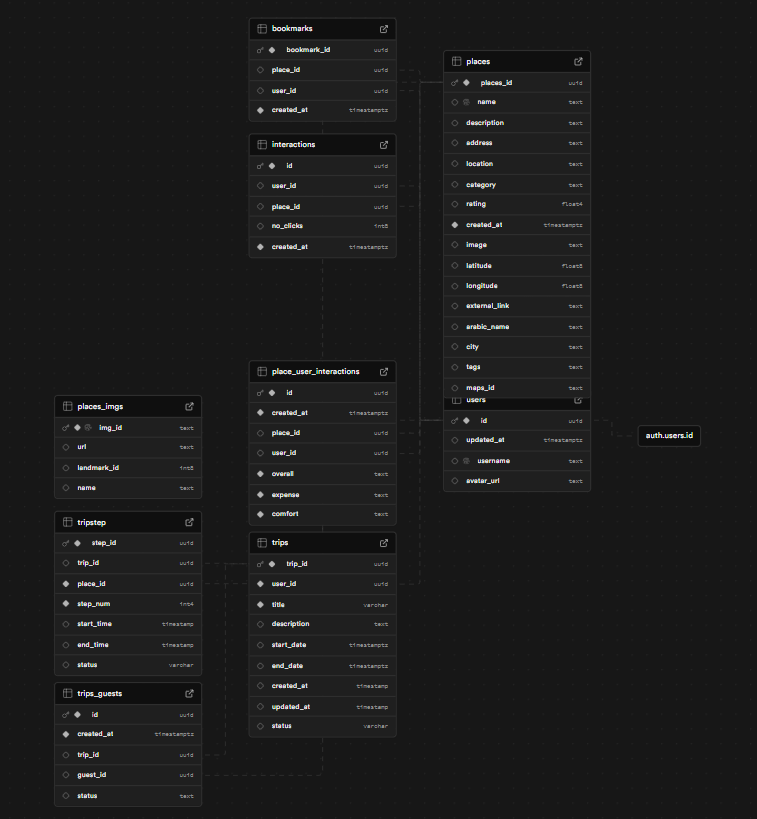- About
- Key Screens and Features
- Technologies Used
- Usage
- Data Completion Engine
- AI Recommendation Model
- Technical Architecture
- Development Lifecycle
- License
BENA is a groundbreaking mobile travel planning application designed to transform how people explore Egypt's rich cultural and historical landscape. More than just a trip planner, BENA is a personalized travel companion that leverages artificial intelligence, geolocation services, and data-driven insights to deliver seamless, engaging, and memorable experiences. Targeting both seasoned explorers and first-time visitors, BENA simplifies trip organization, enhances discovery, and fosters shared travel experiences within a vibrant community. By integrating ancient Egyptian-inspired branding with modern technology, BENA aims to set a new standard for travel apps in the region and beyond.
 |
 |
 |
 |
 |
- Personalized Recommendations: The Explore screen is where users discover personalized recommendations based on their interests and past behavior.
- Curated Categories: The Explore tab is split into different categories to help users discover destinations based on their current mood or plans.
 |
 |
 |
- Al Generation: Automatically generate a trip by using Natural Language, this will connect to our models that will generate a trip tailored for the user's current desires
- Trip planning with detailed list of steps: The page is built to guide users step by step, ensuring that even first-time travelers can create comprehensive itineraries
 |
 |
- Track progress on your travels: Track down the steps to get a live look at your current travels
- Live feedback and easy navigation: Get simple steps to visit your favorite places using the simple navigation bar or edit it to your desires in real time
- Easy and smart to search: The main idea of the search screen is to provide easy access to the most basic needs
- Search by keywords, categories, and/or filters.
- Mobile App: React Native (with Expo)
- Backend: Python (Flask), deployed on AWS EC2
- Database: PostgreSQL (hosted on Supabase) with JSONB support for flexible data storage
- Machine Learning: Scikit-learn (TF-IDF, cosine similarity), NumPy, Pandas
- Mapping: Google Maps API
- Data Enrichment: Wikipedia API
- Styling: Tailwind CSS
- Version Control: Git
- Project Management: Gantt Charts, GitHub Projects
- Sign up or log in to your BENA account.
- Use the Explore tab to discover recommended places and curated categories.
- Use the Smart Search page to search for specific destinations or experiences.
- Plan a trip by using the Trip Creation page, add locations manually, or auto generate a trip using the Al Generation feature using natural language.
- Monitor your progress using the Current Trip page, share live feedback, navigate to your favorite location with a single click.
- Invite collaborators to plan a trip together
The BENA data completion engine enhances the quality and comprehensiveness of place data by automating the following processes:
- Data Extraction: Extracts key information from external APIs (Google Maps API, Wikipedia API) for popular places in Egypt.
- Data Cleaning & De-duplication: Identifies and removes redundant or inaccurate entries from the dataset using a dictionary of unique landmarks.
- Data Enrichment: Augments place data with valuable details such as geographic coordinates, formatted addresses, Arabic titles, and descriptions.
- Localization: Integrates Arabic titles and descriptions to improve accessibility for Arabic-speaking users.
- Database Integration: Stores cleaned and enriched data in a structured format within the Supabase database.
5.1 Specificity and Accuracy
- Google Maps Integration: Ensures addresses and coordinates are accurate and consistent with real-world classifications.
- Wikipedia Data: Provides high-quality, user-generated summaries and language links, enhancing the specificity and relevance of place descriptions.
- Error Handling: Implements basic error handling and logging to identify and address issues such as missing Wikipedia pages or API failures.
The project uses a hybrid recommendation model combining:
- Content-Based Filtering: Uses TF-IDF (Term Frequency-Inverse Document Frequency) and cosine similarity to recommend places with characteristics similar to those the user has bookmarked or interacted with.
- Proximity-Based Recommendations: Utilizes the Haversine formula to calculate distances and recommend nearby destinations to bookmarked ones.
- Hybrid approach: A hybrid system balances relevance based on tags and geographic closeness to create a comprehensive recommendation experience.
4.1.5 Data filtering imperfections
- Code also accounts for data imperfections, by lowing the scores of places without data, or not having an image
Why these machine learning techniques were chosen
- They provide accurate and efficient solutions to a travel app like this.
-
Database Design: Schema overview
-
Modularity: The server-app communication is separated with well defined API models and functionalities for discovery, recommendation, and user personalization
-
Ease of Scale: The AWS EC2 is a service that provides an automatic scaling backend with an easy to scale service from Supabase
-
Real time: Supabase acts as a real time provider for activities such as trip sharing, or live feedback.
- Task Management: GitHub Projects were used to break down tasks into manageable issues, assign responsibilities, prioritize work, and monitor progress.
- Version Control: Git was used for version control, with a structured branching strategy (master, develop, feature branches) and formal commit messages.
This project is licensed under the MIT License.


